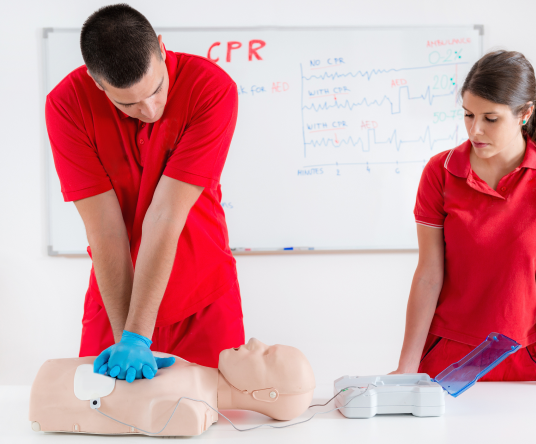Chapter 7: 2-Rescuer CPR and Bag-Mask
When two rescuers are available, CPR can be more efficient by dividing tasks between them. This team-based approach helps maintain the quality of compressions and breathing support.
Rescuer 1 (Compressions):
- Begin chest compressions right away, kneeling at the victim’s side.
- Push down at least 2 inches—but no more than 2.4 inches—at the center of the chest.
- Compress at a rate of 100 to 120 per minute in a cycle of 30 compressions to 2 breaths.
- Let the chest fully rise between each compression.
- Switch roles every 5 cycles or roughly every 2 minutes to avoid fatigue.
Rescuer 2 (Airway and Support):
- Activate the Emergency Response System (call 9-1-1) and retrieve the AED.
- Keep the airway open and deliver 2 breaths after every 30 compressions using a bag-mask.
- Offer encouragement to Rescuer 1 and ensure compressions remain strong and effective.
- If more team members arrive, they can assist with ventilation and AED setup.
Using a Bag-Mask Device
A bag-mask device is common in clinical settings and is used for assisted ventilation. It includes a face mask and a squeezable bag, and connects to high-flow oxygen.
- Choose a mask that covers both the nose and mouth to create a proper seal.
- Avoid pressing the mask down, lift the face into the mask instead.
- Attach the mask to the bag, then to oxygen at a flow of 15 liters per minute.
- Inflate the bag fully before use.
- Open the airway using the head-tilt, chin-lift motion.
- Give 2 rescue breaths, each lasting 1 second.
- Watch for the chest to rise and fall.
- If the chest doesn’t rise, check for blockages, ensure the seal is secure, and try again.
This chapter is part of your BLS for Healthcare CPR/AED and First Aid Combo Course Online Certification, created to help healthcare professionals deliver high-quality care in team-based CPR situations.
